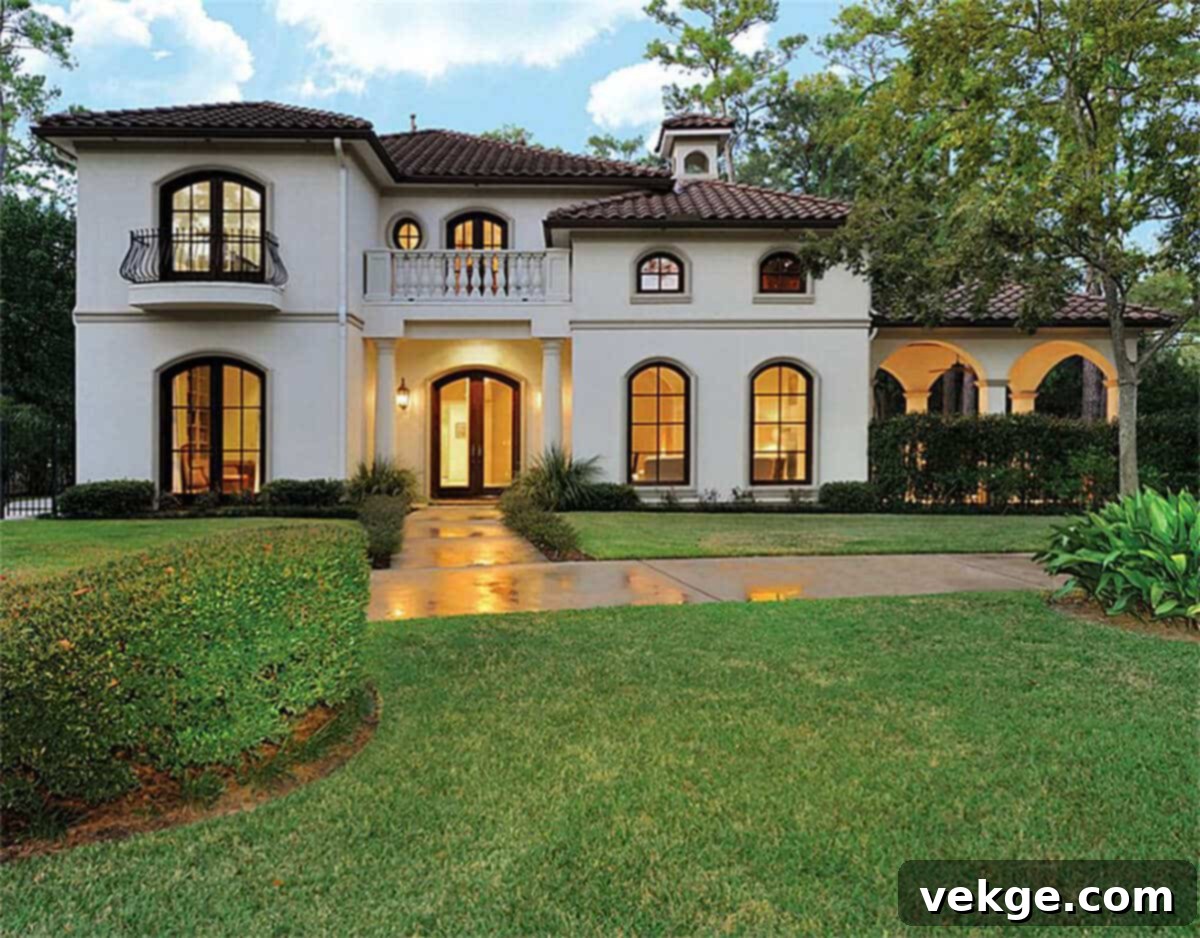The Ultimate Guide to Spanish-Style Homes: Key Features and Mediterranean Design Elements
Among the myriad of architectural styles, Spanish-style homes consistently rank as one of the most beloved and visually stunning choices for residential living. Their inherent beauty, coupled with a harmonious blend of Mediterranean elements, creates an aesthetic that is both captivating and functional. These homes are celebrated for their striking exteriors and equally inviting interiors, leaving a lasting impression on anyone who encounters them.
Often referred to as Spanish Revival homes, this distinctive architectural style made its significant entry into the United States as part of Spanish colonialism. Its enduring charm and practical design, especially suited for warmer climates, ensured its continued popularity. Today, Spanish-style residences remain a prominent and cherished feature in regions such as California, Texas, New Mexico, Arizona, and Florida, where their unique characteristics truly shine.
Beyond their undeniable beauty, these homes are masterfully structured to provide natural cooling, a crucial advantage in the sun-drenched environments where they are most prevalent. This intelligent design prompts many to wonder: what exactly defines a Spanish-style home, and how does it differentiate itself from other popular architectural styles? Let’s delve into the core elements that give these homes their distinct identity and timeless appeal.
Spanish Style Homes: Exploring Their Definitive Features
The distinctive character of a Spanish-style home is not merely a matter of aesthetics; it’s a testament to a thoughtful design philosophy built upon several key features. These elements, working in concert, create an unmistakable look and feel, blending historical reverence with practical considerations. Understanding these features is key to appreciating the charm and enduring legacy of Spanish architecture.
1. Stucco Walls in Light, Earthy Tones
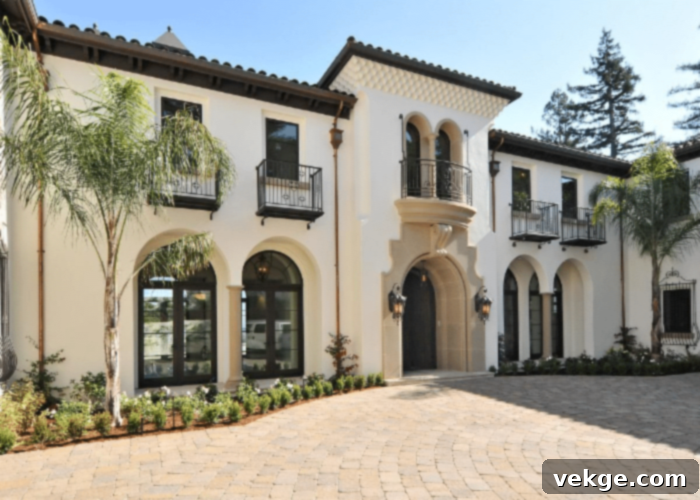
One of the most identifiable and practical features of Spanish-style homes is their reliance on stucco walls, typically rendered in light, earthy colors. This choice is more than just aesthetic; it’s rooted in the need for climate control. Hues like crisp white, warm cream, soft gray, tan, and terracotta reflect sunlight, significantly reducing heat absorption and keeping the interior environment naturally cooler and more comfortable, especially in hot climates.
Stucco, a material composed of cement, sand, lime, and water, provides a durable and robust exterior finish. Its seamless, textured surface lends a distinct artisan feel to the home, reminiscent of traditional Mediterranean villas. Beyond its thermal properties, stucco is also highly resistant to fire, rot, and pests, making it a remarkably reliable and low-maintenance choice for exterior cladding. This combination of practicality, durability, and timeless style ensures that stucco walls remain a cornerstone of Spanish-style architecture, embodying robustness and elegance simultaneously.
2. Iconic Terracotta Tile Roofing
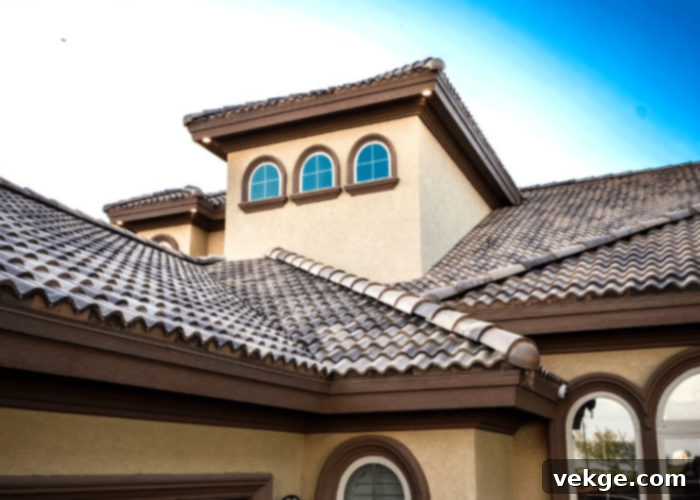
Following the smooth expanse of stucco walls, the distinct red or brownish terracotta tile roofs are arguably the most recognizable characteristic of Spanish-style homes. These “barrel” or “mission” tiles, with their curved forms, were traditionally hand-made, a process that gave each tile a unique, earthy imperfection. While modern manufacturing has introduced more mechanized methods, the essence of their rustic, organic charm remains preserved, maintaining that coveted connection to nature.
The rich, warm hues of these tiles – ranging from deep reds and oranges to earthy browns – offer a striking and visually pleasing contrast against the lighter stucco walls. This color palette is not only aesthetically appealing but also historically significant, reflecting the natural materials readily available in Mediterranean regions. Beyond their beauty, terracotta tiles are exceptionally durable, fire-resistant, and excellent insulators, helping to keep homes cool in summer and warm in winter. Their longevity and ability to withstand harsh weather conditions further cement their status as both a practical and iconic element of Spanish architecture.
3. Exposed Wooden Support Structures
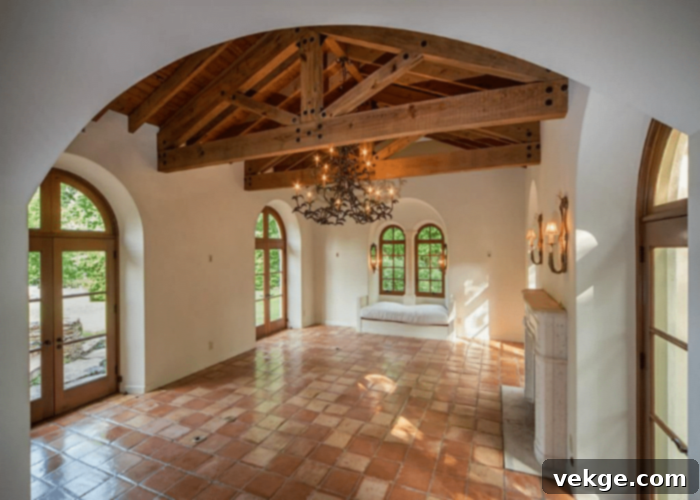
The inclusion of exposed wooden beams and support structures provides another beautiful contrast to the light-colored stucco walls and a defining feature of Spanish-style homes. Historically, these substantial beams were essential structural components, offering robust support to the heavy tile roofs and upper floors. They were a testament to practical engineering and readily available natural resources.
Today, while advancements in construction mean roofs can often bear their weight without exposed internal beams, these wooden elements continue to hold immense value as decorative features. Dark, rich wood beams, often left rough-hewn or stained to highlight their natural grain, add a profound sense of warmth, rustic elegance, and historical authenticity. They define ceilings, frame doorways, and contribute significantly to the cozy, inviting atmosphere that is a hallmark of Spanish interiors. Homeowners frequently use contrasting furniture and accessories to further enhance the sophisticated look created by these prominent wooden features, creating a luxurious and authentic Mediterranean ambiance.
4. Thoughtfully Designed Small Windows
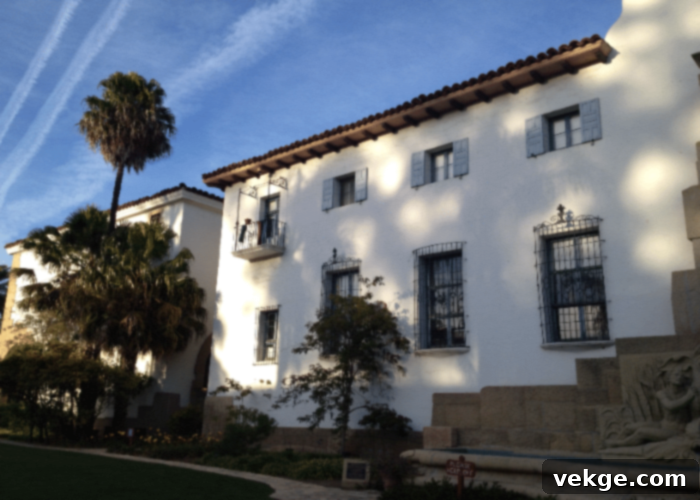
A prominent and often debated feature in Spanish-style architecture is the use of smaller windows. While they undoubtedly contribute to the overall aesthetic, their primary purpose originated from practical considerations. In historically warm regions, smaller windows were a brilliant design solution to minimize direct sunlight penetration and consequent heat gain indoors, all while maintaining crucial ventilation. Deeply recessed into thick stucco walls, these windows also provided additional shade, further enhancing the cooling effect and contributing to the home’s energy efficiency.
The debate about whether smaller windows are an original traditional element or a modern evolution within Spanish Revival homes is ongoing. Some purists argue that larger, more open windows, often overlooking courtyards, were more characteristic of earlier Spanish Colonial designs. Regardless, in contemporary Spanish-style homes, smaller windows have become a cherished aesthetic, often enhanced with decorative iron grilles or wooden shutters, adding to the charm and security of the residence. They imbue the home with a sense of intimacy and historical authenticity that larger, unadorned windows might not achieve.
5. Elegant Wrought Iron Elements
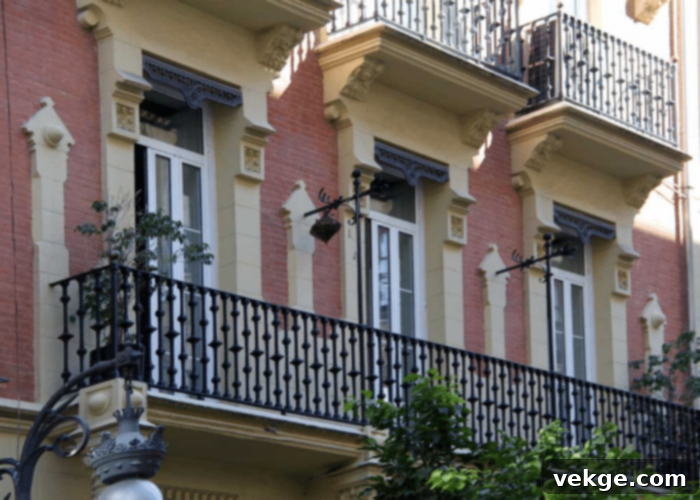
The intricate artistry of wrought iron is an indispensable component of Spanish-style home design, lending an air of minimal elegance, sophistication, and undeniable strength. This durable material is widely employed for a variety of functional and decorative elements, including graceful railings on balconies and staircases, secure window grilles, decorative door hardware, elaborate light fixtures, and sturdy gates. The dark, organic curves and detailed craftsmanship of wrought iron create a beautiful textural and color contrast against the smooth, light stucco walls and warm wooden accents.
The integration of wrought iron elements seamlessly complements the other architectural features, harmonizing with the soft lines of arches and the rustic charm of wooden beams. It adds depth, visual interest, and a touch of old-world grandeur to both the exterior and interior spaces. The extent and placement of wrought iron features, from subtle accents to prominent installations, can be customized to suit individual preferences, allowing homeowners to infuse their personal style while maintaining the authentic spirit of Spanish architecture.
6. Graceful Architectural Arches
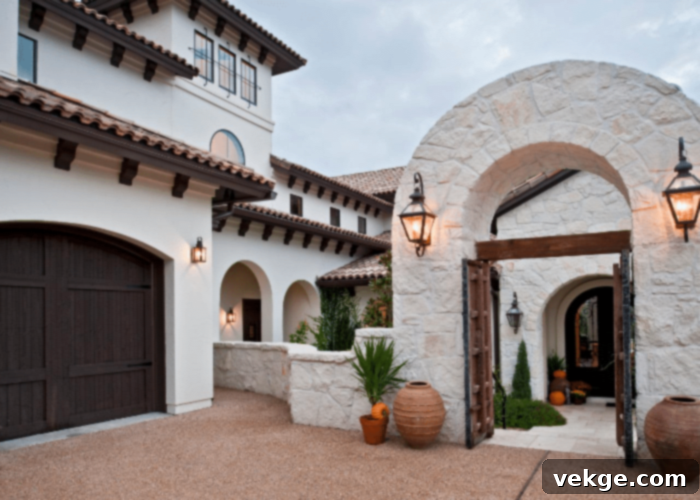
Arches are a truly defining and enchanting feature that significantly elevates the beauty and aesthetic appeal of Spanish-style houses. They introduce a sense of architectural drama, depth, and fluid movement throughout the home, transforming ordinary doorways and passages into elegant transitions. These graceful curves can be incorporated in numerous locations, including entryways, interior hallways, windows, and outdoor loggias, offering structural strength with visual softness.
The versatility of arches allows for various decorative expressions, from simple, unadorned rounded forms that emphasize clean lines to elaborately framed or tiled arches that become focal points. In interiors, they create open yet defined spaces, guiding the eye and enhancing the flow between rooms. On the exterior, arches frequently frame covered patios, verandas, and courtyards, inviting outdoor living and blending seamlessly with the natural environment. Regardless of their complexity, the inherent elegance of rounded arches consistently captivates observers, underscoring the sophisticated charm of Spanish design.
7. Inviting Courtyards or Patios
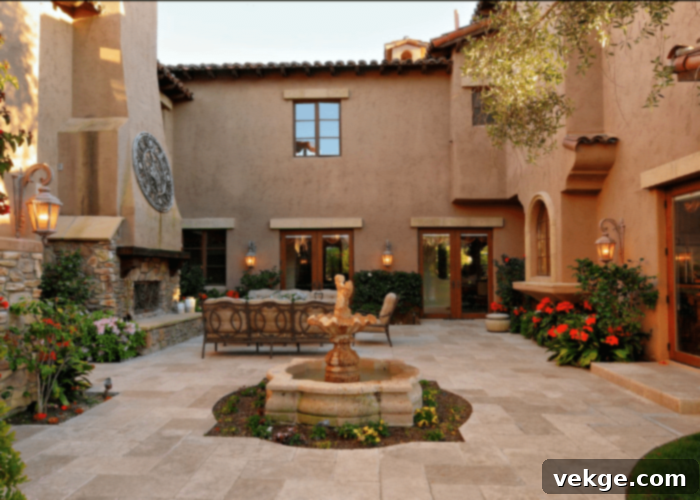
The concept of a central courtyard or patio is perhaps one of the most beloved and historically significant features of traditional Spanish-style homes. These open-air spaces were originally designed as private sanctuaries – tranquil havens where residents could sit, relax, socialize, and enjoy the Mediterranean climate in seclusion. They embody the philosophy of indoor-outdoor living, seamlessly extending the usable space of the home.
Beyond their social function, courtyards also served a crucial environmental purpose. Their open design facilitated natural ventilation, allowing interior heat to escape and cool air to circulate, effectively creating a microclimate within the home’s footprint. Today, courtyards remain a defining characteristic, cherished not only for their practical benefits but overwhelmingly for their aesthetic appeal and the serene ambiance they create. Often adorned with lush plantings, bubbling fountains, decorative tile work, and comfortable seating, these inviting outdoor rooms provide a private oasis and a captivating focal point for the entire residence, encapsulating the essence of Mediterranean living.
Conclusion: Embracing the Timeless Appeal of Spanish-Style Architecture
If you’re envisioning a home that marries classic elegance with modern comfort, offering both simplicity and sophisticated style, then Spanish-style architecture presents an ideal solution. As we’ve explored, these distinctive designs are particularly popular in the sunnier regions of the United States and other warm climates, where their inherent cooling properties and robust materials shine. However, the versatility and timeless beauty of Spanish architecture mean it can be adapted and appreciated in nearly any geographical location, transcending specific environmental needs to offer universal appeal.
While predominantly used for residential spaces, the adaptable nature of Spanish design allows for modifications to suit commercial or industrial settings, offering a unique blend of heritage and contemporary functionality. Achieving this beautiful makeover for your property is more accessible than you might think; by thoughtfully integrating these key features—from the light stucco walls and terracotta roofs to the intricate wrought iron and inviting courtyards—you can bring the charm of the Mediterranean to your doorstep.
With this comprehensive guide, you are now equipped to easily recognize the iconic elements of a Spanish-style home and appreciate the thoughtful design behind each detail. We invite you to share your thoughts in the comments below: Which features of Spanish-style homes do you find most captivating, and how might you incorporate them into your dream living space?
